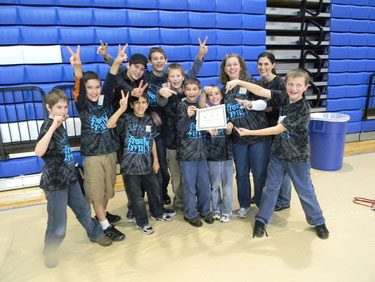| Jan 27, 2011 |
First Lego League team wins second place with nanotechnology project
|
|
(Nanowerk News) The future of science is today.
|
|
Every year, thousands of kids ages 9-14 participate in an event known as First Lego League (FLL). FLL is a friendly competition centered around two main events: creating a robot using the Lego NXT Mindstorms system to perform a set of pre-assigned tasks and a research project. Both the robot game and the research project are centered around a new theme every season.
|
|
When FLL team Storm System learned this year's theme was biomedical engineering, they began to panic. The term "biomedical engineering" was frightening to this group of nine boys based in McKinney, TX. As the team began to narrow down their field of research, they finally decided on the following topic: "How to Destroy Stroke-Causing Blood Clots Through the Use of Nanotechnology".
|
|
"Our coaches thought we were crazy," said team captain Nathan G, age 14. "They kept telling us if it were their choice, we would be researching how to build a set of improved crutches!"
|
|
FLL, however, encourages coaches to merely guide, in order that the children who participate get a real hands-on experience in the world of science and engineering.
|
|
Team Storm System dove into the world of stroke research and nanotechnology. The stroke part went well enough. It was nanotechnology that proved difficult for the team. A relatively new field whose potential is still being discovered, most nanotechnology research is written at a level above the head of most elementary and middle school-aged children. The team came to rely on sources such as the Nanowerk website and the Biomedical Blog, as well as various medical journals. The boys slowly worked their way through it all, reading out loud, dissecting what they could not understand, trying to grasp what they could get out of it all.
|
|
At times, the team seemed ready to give up. They had bit off more than they could chew. Their coaches encouraged them to just keep going.
|
|
"They were getting more out of it than they realized," said coach Kerry Barnard.
|
|
The team finally pulled their research into the required five-minute presentation to be presented in front of a panel of judges in December in Dallas, Texas. Their research earned them a second place finish in the Research Project category and a chance to attend the regional championships early in 2011.
|
 |
|
The Reseach
|
|
Team Storm System researched on how destroy stroke-inducing blood clots through the use of nanotechnology.
|
|
Storm System found that there were many different ways to envision their nanobot. They imagine being able to inject a nanobot made of diamond or silicon directly into the bloodstream after a clot is found. The nanobot would propel itself forward by using a squid-like motion and electricity-generating wheels. A set of "bumpers" would protect the walls of the blood vessels. The wheels would in part help destroy the clot, while any leftover pieces would flow into a storage contained in the nanobot, to be removed by an as-yet-undetermined method.
|
|
"There are still a lot of unanswered questions about the nanotechnology part of our research," said participant Luke A. "But then, there are still a lot of unanswered questions in nanotechnology itself."
|
|
The Future of Science
|
|
Team Storm System is a good example of how FLL sees itself beneficial to the world of science. Getting kids excited about a robot and legos opens the door to an experience of research and hands-on engineering and programming many kids may be pre-disposed to think they are no good at. Just this one experience may change the vision of children who will become the future researchers and scientists of tomorrow.
|
|
For more information on First Lego League, visit www.usfirst.org.
|

